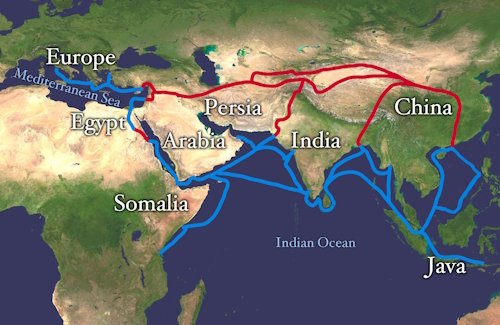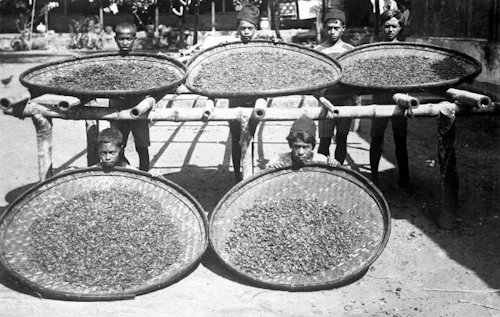First published: Sun 18 Aug 2024.
Els Slots
Spice (Route(s)) WHS
Comments
8 comments
Jay T
1 year, 4 months ago (Aug 18, 2024)
On the marketing side of spice, I have fond memories of the Spice Bazaar in Istanbul, with its piles of
turmeric and pepper.
I've visited two components of The Incense Route of the Negev, but as far as Nabatean trade goes, I don't remember the information panels highlighting spice trade as much as trade in frankincense and myrhh. It's been a couple years since I visited, though.
For Indonesia's proposed spice trade route, while I'd like to see cultural landscapes, it might become a bit unwieldy unless they choose a best example or two for cloves and for nutmeg and mace. I'd be interested in buildings that show off the wealth from the spice trade, too (similar to Bahrain's pearling path); perhaps mosques or buildings associated with the sultanate of Ternate (the current kraton was built in the early 19th century, though; I'm not sure what remains of the earlier palace). If there are any existing storehouses, I think those might also be of interest.
Reply
Solivagant
1 year, 4 months ago (Aug 18, 2024)
Both Liverpool and Hamburg were significant ports for the import of spices.....The former is now irrelevant but the latter has a modern spice museum in the Speicherstadt telling the story
https://www.hamburg.com/visitors/museums/spicys-22752
It is referred to in the Hamburg nomination file and there are several references also to the spice trade as a part of the site's history e.g "Traditionally, coffee and tea, cocoa, dried fruit, nuts, spices and other such precious delicacies were the most important goods stored in the Speicherstadt. For more than a hundred years, the storage, transhipment
and processing of these products were
the main occupations of specialised merchants and independent storage managers and quality surveyors (Quartiersleute)."
Solivagant
1 year, 4 months ago (Aug 18, 2024)
The name of the town derives from "saffron" and the Greek word polis (πόλις) meaning "city", since Safranbolu was a trading place and a center for growing saffron. Today, saffron is still grown at the village of Davutobası to the east of Safranbolu, with a road distance of 22 kilometres".
Iran produces over 90% of the worlds saffron - mainly in the NE and is "Qanat grown". Today particularly around Gonabad - but that Qanat seems primarily to have been inscribed for its history....
Unfortunately neither Safranabolu nor the Qanats have a referable Nomination File
It could be that mixing all the "spices" together gets too large?
Solivagant
1 year, 4 months ago (Aug 18, 2024)
this specifically links the Qasabeh Qanat of Iran at Gonabad to the production of saffron
https://openknowledge.fao.org/server/api/core/bitstreams/eba99b12-2d28-4a75-8b02-dab8303593de/content
Solivagant
1 year, 4 months ago (Aug 18, 2024)
and of course the Western Ghats are linked to Spices.....The Cardamom Hills produce....Cardamom! Both wild and cultivated...numerous references in the nomination
Dwikusuma
1 year, 3 months ago (Aug 23, 2024)
I want to comment on Indonesia's proposed spice trade route. As I understand, there are 150 sites identified as part of this proposal. The proposed sites include all locations connected to the spice trade from the 13th to the 18th century. These sites consist of graveyards, mosques built by traders, fortresses, palaces, and so on. I estimate that this nomination will encompass at least three sites from Indonesia’s tentative list, such as Banda, Semarang, and Jakarta, as well as one former tentative site, Banten Ancient City. The nomination will also include other historically significant sites, such as Fort Rotterdam and Barus, as well as sites with the potential to become World Heritage Sites independently, such as Ternate-Tidore, Buton Fortress, and Lasem.
I believe that proposing 150 sites could pose a problem for the nomination due to concerns about authenticity. Many of these sites are living heritage, such as mosques, which have undergone unauthorized renovations without archaeological or architectural assistance, thereby compromising their historical integrity. Additionally, there is a management plan issue, as Indonesia may need to improve its capacity to preserve and manage such a large number of sites.
Christravelblog
1 year, 3 months ago (Aug 24, 2024)
These “large” inscriptions are for me always a discussion with myself if I like it or not. At one point I understand but at the other hand what serial sites you want to make more. In my opinion it works if single sites would not suffice and or to small or uninteresting on its own. If however several sites together make up a good value then yes. But, also, if most major sites are already inscribed on its own I would see to reconsider if they need to be single listed or have more UOV being in the serial.



